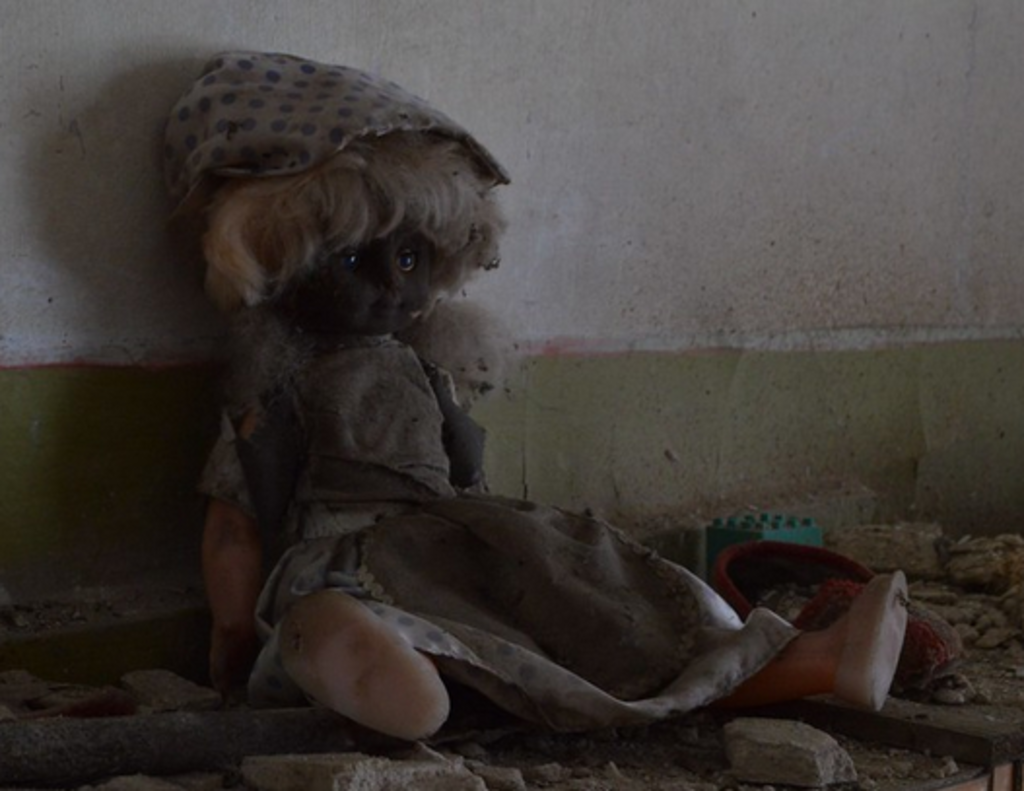Introduction
Unsurprisingly, it’s very common for artists of all kinds to engage in conversation with pressing political themes and current events. There are many cases of music stemming from tragedy or grievance; music is something that has a powerful ability to convey human emotion, whether melancholy, happy, hopeful, or angry. However, some music that deals with political messages or contains references to disaster isn’t necessarily intended to be interpreted as emotional. Often music can even have a darker underlying theme but sound upbeat and catchy if the lyrics are ignored.
Chernobyl, although having occurred in Ukraine, had significance well beyond national borders and has taken on symbolic cultural meaning reflective of the fears of the time. In addition to literature, poetry, visual art, and film, there has also been music both recent and from past decades that references or draws upon themes from Chernobyl. I believe it’s significant to look at how Chernobyl is referenced in works of music as it is representative of the broad cultural impact of Chernobyl both within and outside of Ukraine.
These works of music, coming from different places around the world, including Japan and Germany, demonstrate the transnational political and cultural resonance of Chernobyl. It is also necessary to point out that some of these works were created more for artistic value or entertainment rather than to be made with representative knowledge of the tragedy of Chernobyl and its victims. However, it’s notable that these particular works of music demonstrate Chernobyl’s relevance in history and culture, and there are still many pertinent themes and messages to be drawn from the lyrics. For example, David Bowie’s “Time Will Crawl” and The Blue Hearts’ “Chernobyl” were both produced in the 80s and reflect the anti-nuclear sentiment of the time period. These songs were made to be commercially successful and entertaining and were definitely not intended as thoughtful representations of the tragedy of Chernobyl. Despite these potential flaws, they are significant as popular works of music which played upon the themes of distrust in nuclear power and fear of environmental impact.
Eastern Europe
“Sweet People” - Alyosha (2010)
“Sweet People” is by Ukrainian singer Alyosha and was Ukraine’s entry in 2010 at the Eurovision Song Contest. Although her song doesn’t specifically mention Chernobyl, it is an emotional cry to environmental action, and her music video was shot entirely in the abandoned city of Pripyat. In her lyrics, she sings “Don't turn all the earth to stone / Because, because, because / This is your home / Oh, sweet people / What about our children?” In an interview during the Eurovision Song Contest, Alyosha said that “The disaster at the Chornobyl nuclear power plant is one of the darkest pages in the history of my country, but there are ‘Chernobyls’ waiting to happen and calling for urgent action on the global level in many other nations worldwide. We turned to the emotive images of Chernobyl in our video because they are a very powerful reminder of what negligence, irresponsibility and inaction of ‘sweet people’ can lead to.”1 She wants to urge people not to live in ignorance but to take action to prevent future environmental catastrophes and protect generations of people to come who shouldn’t have to inherit the burden of a damaged planet. This is an important message, but it’s also fair to critique Alyosha’s use of Chernobyl in her music video. The fact that Chernobyl was much more than just an environmental issue is a bit lost when watching her music video; viewers just see shots of Alyosha singing in various apocalyptic-looking sites. Chernobyl was of course environmentally damaging, but it wasn’t caused by the inaction of “sweet people,” but was rather an unprecedented accident. Her music video does not address the victims of Chernobyl and her lyrics do not even specifically reference Chernobyl, which suggests that the choice to film the video in Pripyat was to add to the entertainment value or give the song more of an impact to people who associate Chernobyl merely with environmental degradation.
“Collection of Songs About Chernobyl” - Sergei Uryyin (1986)
“Collection of Songs About Chernobyl” are a series of short songs in folk style sung in Russian by Sergei Uryyin. In one of his songs, “What is impossible in Chernobyl,” his lyrics roughly translate to: “Chernobyl - I tell you, my friends / The capital of worldly temptations, / Which cannot be succumbed to.” I interpret this idea to refer to the fact that despite Chernobyl seeming “normal” and full of available food and other “temptations” following the accident, everything was much more dangerous than the eye could register due to the unseen force of deadly radiation permeating the air. People were told that crops and food items, among other things, were contaminated. The danger of radiation is something that would be hard to process or believe due to its eerily invisibility, but it would have been easy to almost not be conscious of its indiscernible presence.
Chornobyl Songs Project: Living Culture from a Lost World
- Ensemble Hilka (2015)
Chornobyl Songs Project: Living Culture from a Lost World is a collection of songs released by Smithsonian Folkways featuring folk songs in the traditional style of those that would have been sung in the region surrounding Chernobyl for centuries prior. Some of the song titles in the album include, “Church carol,” “Spring ritual song,” “Soldier’s song,” and “Wedding song.” The songs are sung in Ukrainian and the accompanying instrument is the fiddle. The collection represents an attempt to commemorate a culture’s traditional music because of the displacement of the people in the Polesian region and the “resurgent interest in traditional music (such as the songs produced in this album) during and after the waning years of the Soviet Union.”2 In this sense, the “Chornobyl Songs Project” is a rare example music created in relation to Chernobyl that serves a purpose beyond just entertainment or sharing a political message; the volume pays tribute to an aspect of culture which otherwise could be completely lost due to the abandonment of the region contaminated by Chernobyl’s radioactive fallout.
Outside of Eastern Europe

“Time Will Crawl” - David Bowie (1987)
David Bowie’s “Time Will Crawl” is about the environmental destruction of the planet, and Bowie noted that it inspired by Chernobyl. He was in Switzerland at the time of the disaster and has said in an interview that “huge billowing clouds were moving over from the Motherland and they weren’t rain clouds… For those first few moments it felt sort of claustrophobic to know you were one of only a few witnesses to something of this magnitude… Over the next couple of months a complicated crucible of impressions collected in my head prompted by this insanity, any one of which could have become a song. I stuck them all in ‘Time Will Crawl.’”3 The song is a protest against negative environmental impact caused by industry, and the lyrics from the song that draw upon Chernobyl specifically are “I felt a warm warm breeze / That melted metal and steel / I got a bad migraine / That lasted three long years.” These lines reference the cloud of radiation, or the “warm breeze,” which would have affected Bowie at the time he was in Switzerland.
“Chernobyl” - The Blue Hearts (1991)
The Blue Hearts were a Japanese punk rock band and “Chernobyl” was a statement against nuclear power with the line “I don’t want to go to Chernobyl” in the chorus; the inclusion of the song in their album was controversial and forced them to leave their record label, which had a sponsor invested heavily in nuclear energy.4 “Chernobyl” has an anti-nuclear message but similarly to “Time Will Crawl,” couches it within quite entertaining music. It’s an incredibly upbeat and catchy rock song; one probably wouldn’t immediately recognize its deeper protest message until close listening or further investigation.
“Radioactivity” - Kraftwerk (1991)
“Radioactivity,” by German electronic band Kraftwerk, was released before Chernobyl in 1976 but re-recorded in 1991 with a clearer anti-nuclear attitude and specific inclusion of Chernobyl’s name. The new lyrics reference not only Chernobyl, but other disasters such as Hiroshima and Three Mile Island. They sing “Chain reaction and mutation / Contaminated population / Stop radioactivity / Is in the air for you and me.” Chernobyl’s wide global reverberations show that it came to be a symbol of sorts for an anti-nuclear or environmentalist sentiment.
Conclusion
Perhaps the example of Chernobyl shows that people around the world will interpret and attach meaning to tragedy to make sense of it and this can be in the form of music. Although people may not have deeply understood the impact of Chernobyl on those affected, it certainly represented something significant and terrible with enough meaning associated to be referenced in music.
Bibliography
- Alyosha. “Sweet People (Ukraine).” Eurovision Song Contest. YouTube, uploaded by Eurovision Song Contest, 18 May 2010.
- Bowie, David. “Time Will Crawl (Official Video).” YouTube, uploaded by David Bowie, 29 June 29 2018.
- Ensemble Hilka. Chornobyl Songs Project: Living Culture from a Lost World. Producer Maria Sonevytsky in association with The Center for Traditional Music and Dance and The Yara Arts Group. Annotated by Maria Sonevytsky with Yevhen Yefremov. Smithsonian Folkways Recordings. CD (1), SFW CD 50420.
- Kraftwerk. “Radioactivity.” The Mix, 1991. Rhino/Electra. YouTube, uploaded by Kraftwerk, 25 January 2017.
- The Blue Hearts. “Chernobyl.” Blue Hearts Theme, 1988. Onkio Haus. YouTube, uploaded by ClutchK, 2 December 2007.
- Uryvin, Sergei. Сборник песен про Чернобыль [Collection of Songs about Chernobyl], 1986. YouTube, uploaded by John Tafft, 20 October 2017.
- Uryvin, Sergei. Lyrics to Сборник песен про Чернобыль [Collection of Songs about Chernobyl].
- Автомат и гитара: Стихи и песни из солдатских блокнотов [Machine Gun and Guitar: Poems and Songs from Soldiers’ Notebooks].”
Works Cited
-
Mourinho, Daniel. “‘Sweet People’ – Alyosha’s True Message to Represent Ukraine.” ESC Radio - Eurovision Song Contest Eurosong Webradio, ESC Radio - Eurovision Song Contest Eurosong Webradio, 28 Apr. 2010. ↩
-
Mussachia, Matthew. “Sound Reviews.” Journal of American Folklore, 2017, p. 115. ↩
-
Bowie, David. “DAVID BOWIE: I Went to Buy Some Shoes - and I Came Back with Life On Mars.” Daily Mail Online, Associated Newspapers, 28 June 2008. ↩
-
Manabe, Noriko. “Musicians in the Antinuclear Movement.” The Revolution Will Not Be Televised: Protest Music after Fukushima. Oxford University Press, 2016, pp. 77–77. ↩
Caroline EC
RUSS043 Chernobyl: Nuclear Naratives and the Environment, Swarthmore College, Spring 2020



